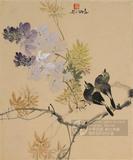唐人春郊遊騎圖 軸
推薦分享
資源連結
連結到原始資料 (您即將開啟新視窗離開本站)後設資料
- 資料識別:
- 故畫000014N000000000
- 資料類型:
- 類型:繪畫
- 型式:靜態圖像
- 主題與關鍵字:
- 春景 江河、湖海 高士(士人、隱士) 官員(臣) 馬 麻雀 飲食器 耕織漁獵 樂器 櫸
- 出版者:
- 數位化執行單位:國立故宮博物院
- 格式:
- 本幅 150.5x104.5公分、全幅 106.5公分
- 關聯:
- 石渠寶笈續編(乾清宮),第一冊,頁287 &*故宮書畫錄(卷五),第三冊,頁13&*故宮書畫圖錄,第一冊,頁41-42&*遊騎七人,畫幅中間一人上身呈正面,穿著與其他六人不同,應是畫中的主人。前二人引導,後四人有的拿弓,有的拿毬棍,有的挾著琴,有的背酒,前顧後盼,各有神態。樹葉雙鉤填彩,岩石、流水和激湍都是仿古的鉤勒法,有裝飾的意味。背景樹石的構圖和院藏另一件傳為韓幹「猿馬圖」相似,不過筆墨稍遜,可能出自同一幅稿本。 這幅畫沒有作者的款印,舊傳為唐人。從畫法看,時代較晚,畫中主人正面像類似明代中期畫皇帝像風格,可能出自明代宮廷畫家之手。 &*In this painting, seven riders are seen on an outing. The figure in the center is rendered frontally and wears clothing different from the other six, indicating that he may be the host. Two figures are in the lead and the others are behind carrying such items as a sword, polo club, lute, and wine. The tree leaves were done in outlines filled with colors, while the earthen forms and water were all done in imitation of an ancient method of outlining and washes of color to give the painting a decorative effect. The trees and forms in the background are similar to those in a painting attributed to Han Kan (fl. 8th c.) entitled "Gibbons and Horses" in the Museum collection, but slightly weaker in terms of brush and ink. It thus may have been done after the same original. This painting bears neither signature nor seal of the artist and was attributed in the past to an anonymous artist of the T'ang. Judging from the style, the painting appears to date to a later period. The host figure appears similar in manner to imperial portraits from the middle Ming dynasty (1368-1644), indicating that it may have come from the hand of a Ming court painter. &*遊騎七人,畫幅中間一人上身呈正面,穿著與其他六人不同,應是畫中的主人。前二人引導,後四人有的拿弓,有的拿毬棍,有的挾著琴,有的揹酒,前顧後盼,各有神態。背景樹石的構圖和院藏另一件傳為韓幹〈猿馬圖〉相似,可能出自同一幅稿本。這幅畫沒有作者的款印,舊傳為唐人。從畫法看,畫中主人正面像類似明代中期畫皇帝像風格,可能出自明代宮廷畫家之手。(20100710)&* In this work are 7 riders on a horseback outing. The figure in the middle appears frontal and wears clothing different from the others, suggesting he may be the host of the trip. Two figures are in the lead, and others behind carry such items as a sword, polo club, lute, and wine. The composition of trees and forms in the background is similar to another work in the Museum collection, “Gibbons and Horses” attributed to Han Gan (fl. 8th c.), and may have come from the same original. This work has no seal or signature of the artist and has an old attribution to a Tang artist. The method of frontal rendering for the host in the center is similar to imperial portrayals in the middle Ming (1368-1644), suggesting it may have been done by a Ming court artist.(20100710)
- 管理權:
- 國立故宮博物院
授權聯絡窗口
- 國立故宮博物院圖像授權、出版授權、影音資料授權-申請流程說明
http://www.npm.gov.tw/zh-TW/Article.aspx?sNo=03003061






